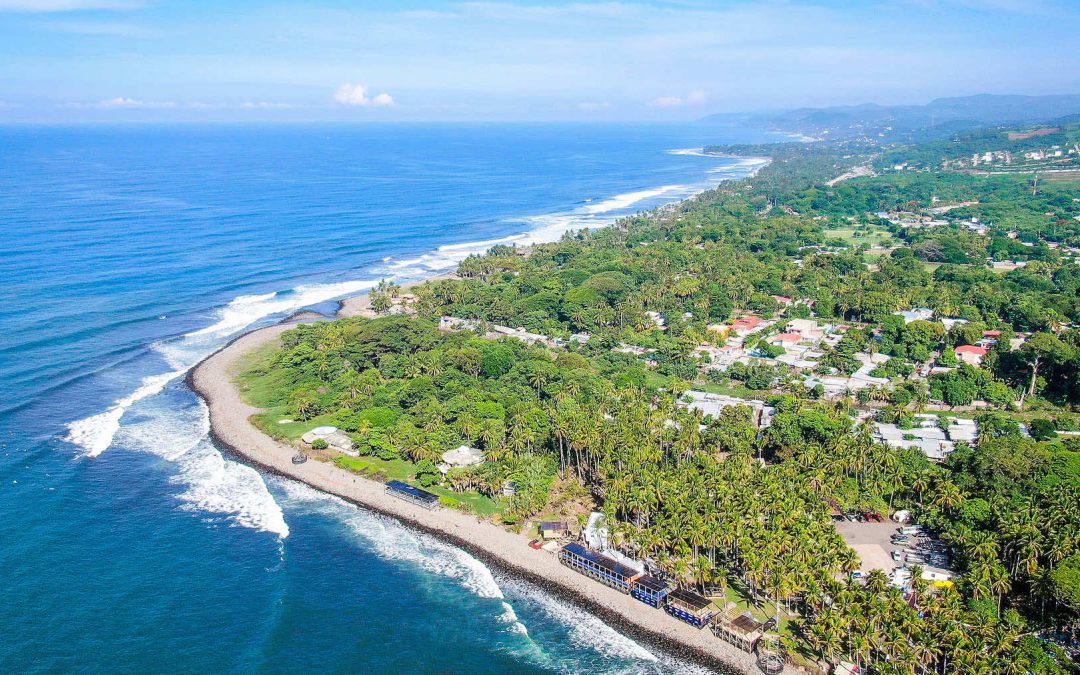Welcome to Min-On’s Music Journey! Today, the Min-On Concert Association and the Embassy of the Republic of El Salvador in Japan welcome you to El Salvador, a tropical country located in Central America.
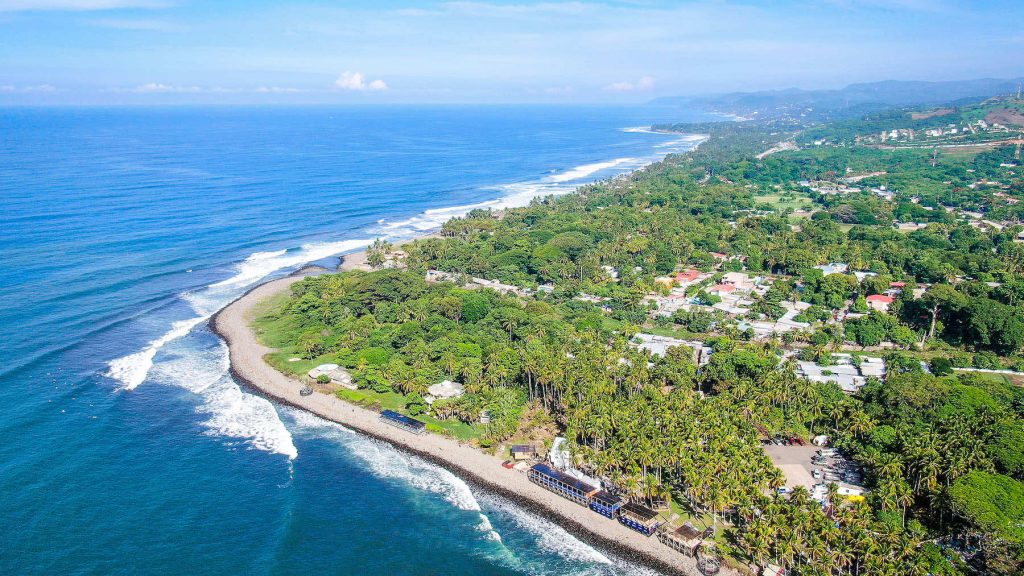
© El Salvador Travel
El Salvador borders the northern Pacific Ocean and boasts a myriad of natural wonders, including beautiful coastline and a number of mountain ranges. It is the smallest of the seven Central American countries, with an area of 21,040 km², but the number of things to do – and places to see – is drawing more and more visitors every year.
| Travel guide:
・Tour the best places in San Salvador ・Eat your fill of piping hot pupusas at a San Salvadoran market ・Visit ancient Mayan ruins ・Watch the gorgeous sunset at El Tunco Beach |
What kind of country is El Salvador?
El Salvador has many things in common with Japan, to the point that it has even been called « the Japan of Central America. » Before we set out on our journey, let’s take a look at the national character and natural environment of El Salvador.
High levels of volcanic activity
El Salvador has over 25 volcanoes, making it one of the most volcanically active countries in the world. This is very similar to Japan, which has 10% of the active volcanoes in the world.
Among the volcanoes in El Salvador, Izalco used to be the most active in Central America, and has erupted more than 50 times from 1770 up to 1960. The burning red summit could be seen from far offshore, earning it the nickname « The Pacific Lighthouse. » Nowadays it remains active but with no eruptive activity, and it offers climbing tours with professional guides.
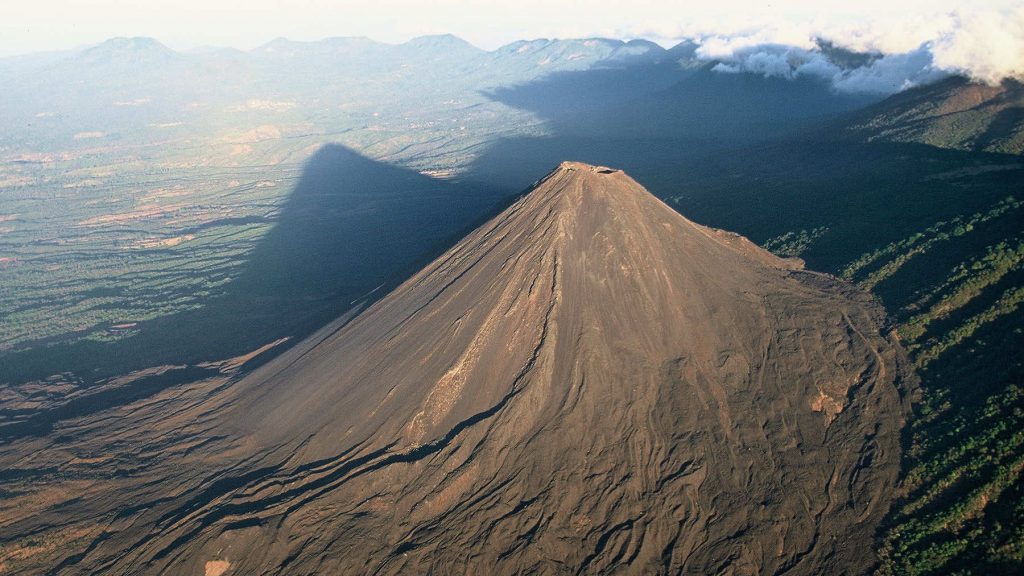 Izalco © El Salvador Travel
Izalco © El Salvador Travel
A persevering, diligent national character
El Salvador has a long history of natural disasters, including volcanic eruptions, earthquakes and hurricanes. Also, due the outbreak of civil war in 1980, the gap between rich and poor caused public security in urban areas to suffer greatly. These challenges have been strongly approached since 2019 and by 2022, El Salvador has greatly increased the levels of public security and safety, becoming the Central American country with highest levels of tourism in the last two years.
The country also has high population density and limited natural resources, and its people have endured many hardships throughout history to survive. A population of enduring and diligent workers arose naturally in this environment.
The national attitude of persevering in the face of challenges – including repeated natural disasters and limited resources – paired with a dense population is another aspect that El Salvador shares with Japan. Let’s begin our journey today with a piece that represents this brave, powerful national character – El Salvador’s national anthem, Himno Nacional de El Salvador.
The historic capital of San Salvador
El Salvador International Airport is the gateway to the country, and we recommend heading straight to San Salvador for first-time visitors. San Salvador means « holy savior » in Spanish, and the city is an important center of politics and economic support for the country.
The city center, filled with popular destinations
The center of San Salvador is a modern area packed with high-tech office buildings and commercial establishments. On the other hand, it is also a historic district where many important structures like the National Theater, National Palace, the Metropolitan Cathedral and El Rosario Church still remain.
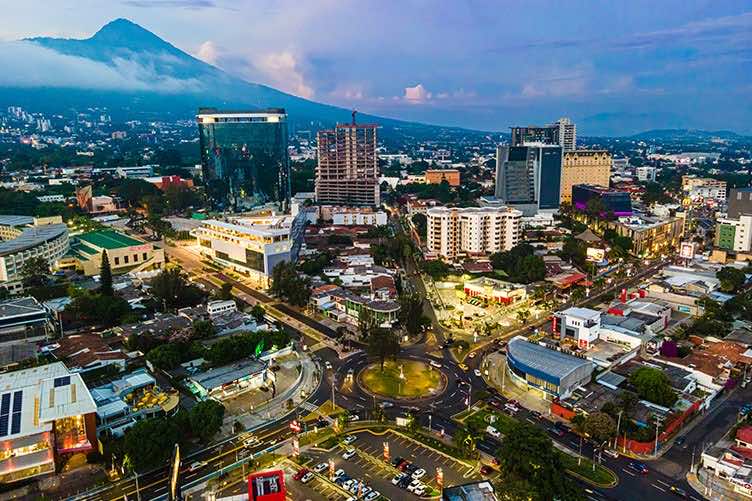
© El Salvador Travel
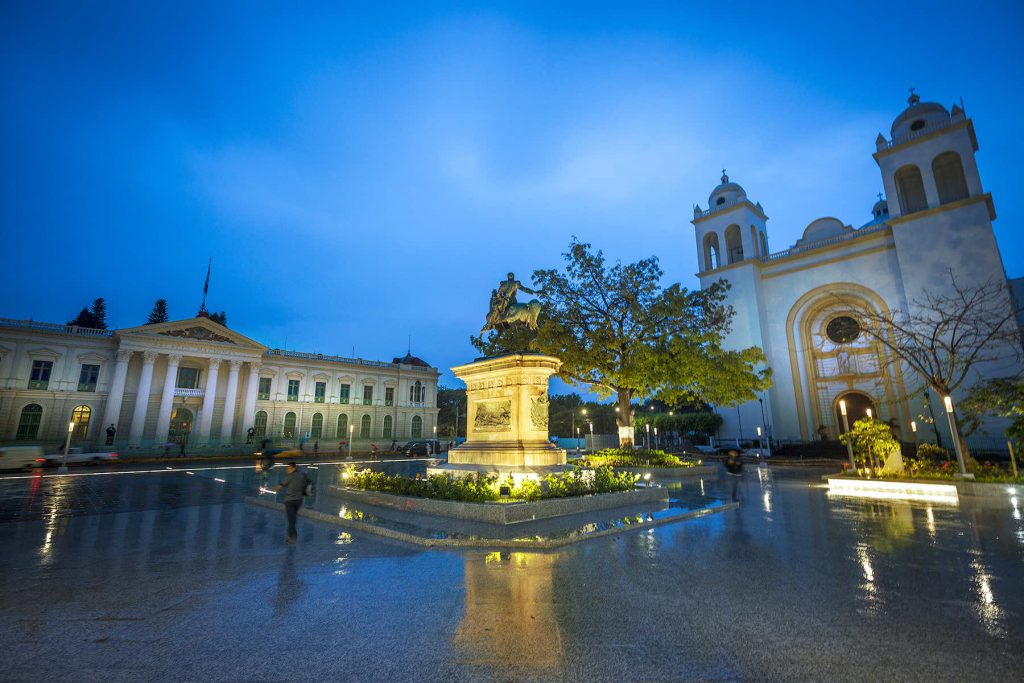
National Palace and Metropolitan Cathedral © El Salvador Travel
El Rosario Church in particular is a popular sightseeing destination. The sight of the sunlight transformed into a rainbow of colors streaming through the beautiful stained glass windows creates a space so magical it’s easy to forget time altogether.
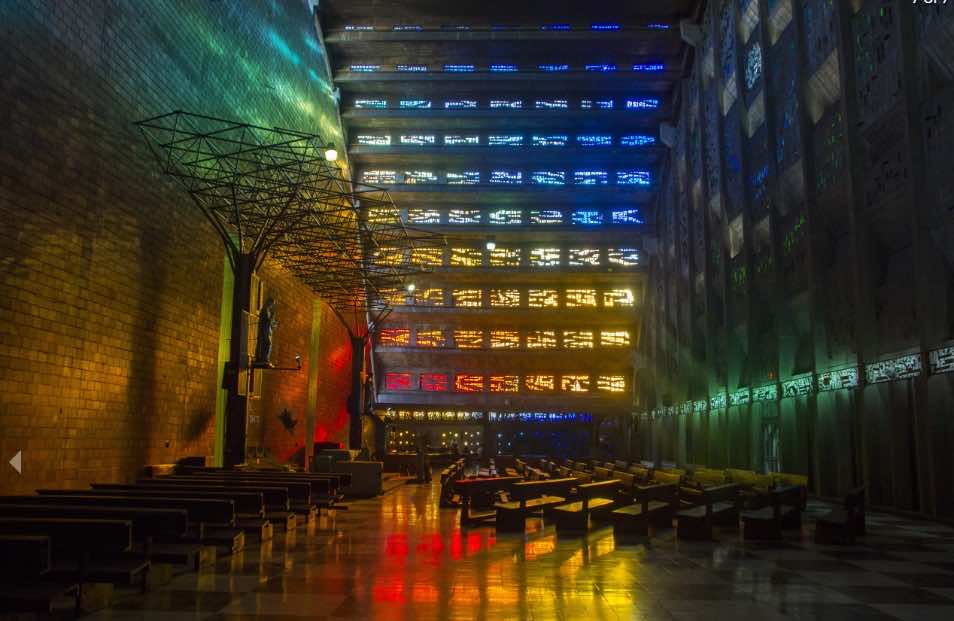
© El Salvador Travel
The National Theater is home to great expressions of classical and modern music in El Salvador: the National Symphonic Orchestra, the National Ballet and the National Folkloric Ballet often hold their presentations for the delight of the public, showing a wide range of repertories of international and national compositions.
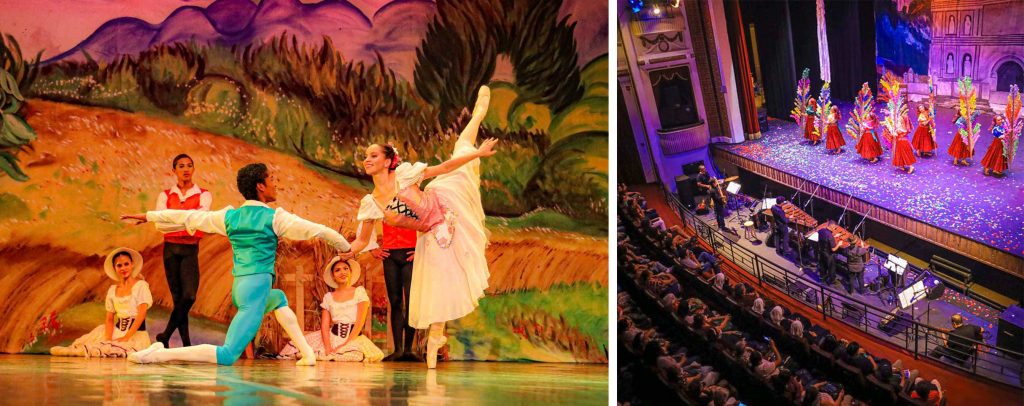 National Ballet ©Ministerio de Cultura de El Salvador
National Ballet ©Ministerio de Cultura de El Salvador
Pupusa, a local specialty
During the day, the historic district hosts a market filled with many street stalls and food carts. Visitors will find the market buzzing with locals enjoying shopping and food.
One dish visitors should definitely try is the Salvadoran specialty called pupusa. These thick griddle cakes or flatbreads are made with cornmeal-based dough and filled with pork or chicken meat, melted cheese or mashed beans, and you can also find vegetarian options. They’re typically eaten with curtido (a fermented cabbage slaw) or tomato salsa.
The pupusa is a handmade dish, and the production process is similar to hand made tortillas, where each flour round piece is filled with different ingredients and then placed on a hot grill. Several traditional folklore music pieces of El Salvador are inspired
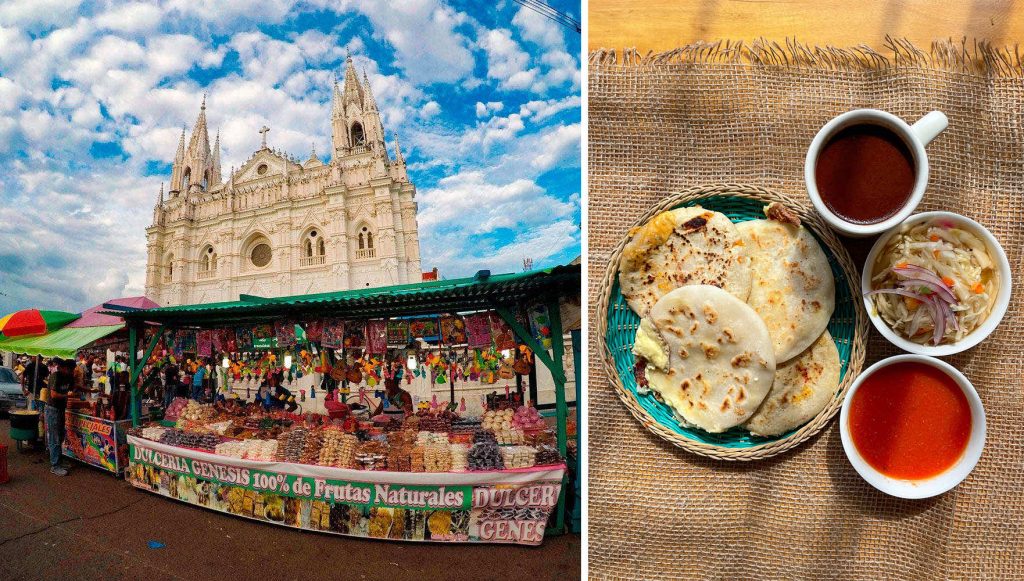 © El Salvador Travel
© El Salvador Travel
Santa Ana, area of coffee and mountains
Heading 1.5 hours northwest of San Salvador leads to Santa Ana, the second largest city in El Salvador and a major producer of coffee and sugarcane. Coffee in particular makes up 30% of local agricultural production.
El Salvador is famous for being the birthplace of the world-famous coffee variety called “pacamara”, created since 1985. Additionally, Salvadoran coffee is known for its naturally honey-like, gentle sweetness, thanks to a unique refining method called « honey processing. »
 © El Salvador Travel
© El Salvador Travel
Visitors can unwind with a cup of the local brew in one of Santa Ana’s many cafes and enjoy the beautiful, majestic structures like the Santa Ana National Theater, which was built in 1889, and the city’s cathedral that blends Gothic and Byzantine architecture.
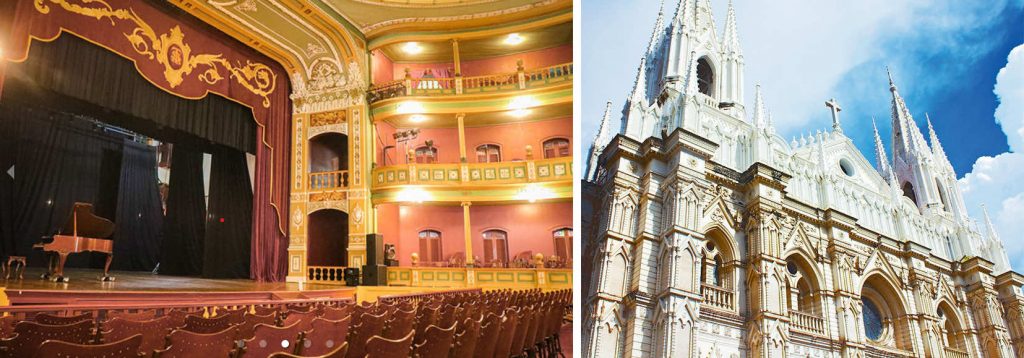 National Theater and Cathedral © El Salvador Travel
National Theater and Cathedral © El Salvador Travel
Santa Ana city is located within the department of the same name, which has many wonderful tourism spots offering mountain treks, coffee plantation tours, and the unforgettable visit to Coatepeque Lake, a color-changing body of water nestled inside the dormant volcano hills.
This area is the also the origin place for folkloric music, including the colorful “Coffee Pickers” traditional dance.
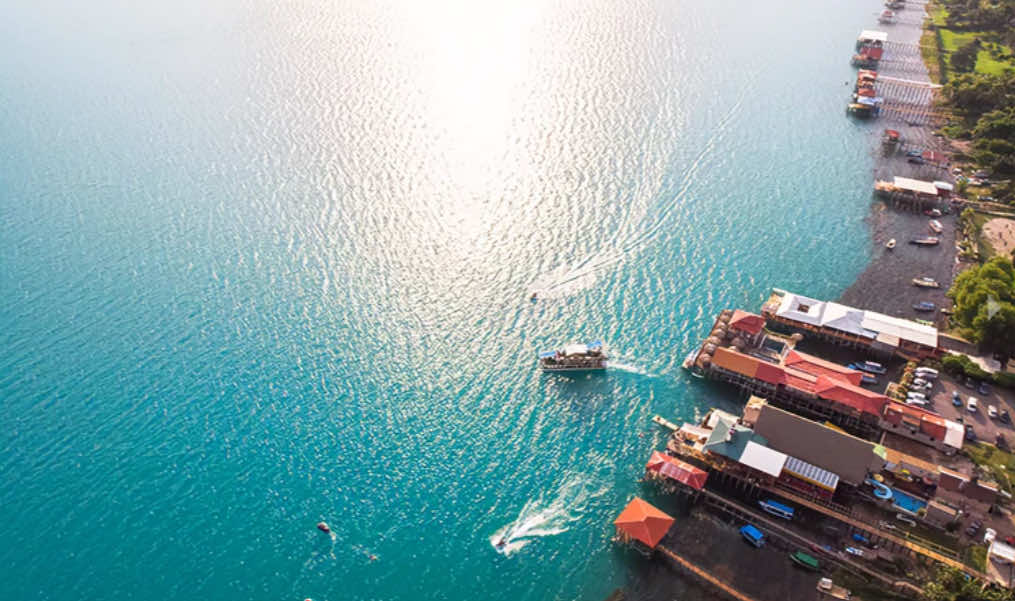
Coatepeque Lake © El Salvador Travel

©MITUR El Salvador (left) ©Ministerio de Cultura de El Salvador (right)
The Salvadoran coast – surfer’s paradise
The coast of El Salvador has many beaches that are considered surfer’s paradise, thanks to their great waves and easy accessibility from the US. El Salvador has been gaining popularity as a surfing destination, even hosting international competitions that serve as Olympic qualifiers.
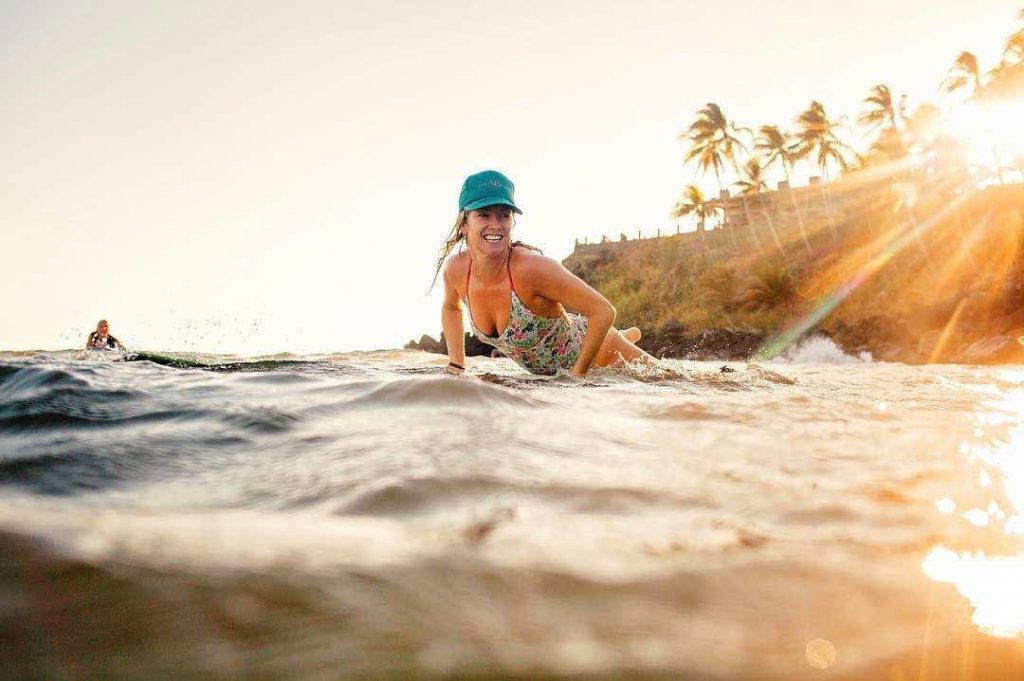
© El Salvador Travel
El Tunco Beach, known for the rock formation jutting out of the water near its shore, is an iconic surfing spot not far from San Salvador. There are many other beaches with different types of waves on the coast, like El Sunzal and La Bocana, where the ISA (International Surfing Federation) World Championships were held in 2021, and El Zonte, which is also known as « Bitcoin Beach. »
The Salvadorean coast is the place where tropical rhythms can most commonly be found, including international and national cumbia and salsa songs. Several modern groups are also integrating cumbia and salsa with the reggaeton style, as music often played during beach festivals and concerts.
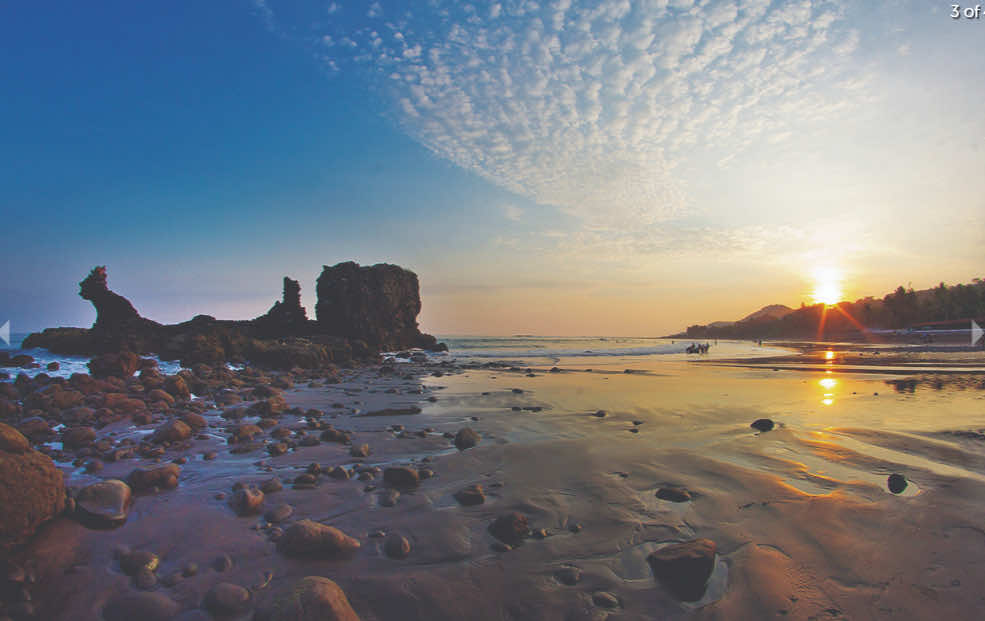
El Tunco Beach © El Salvador Travel
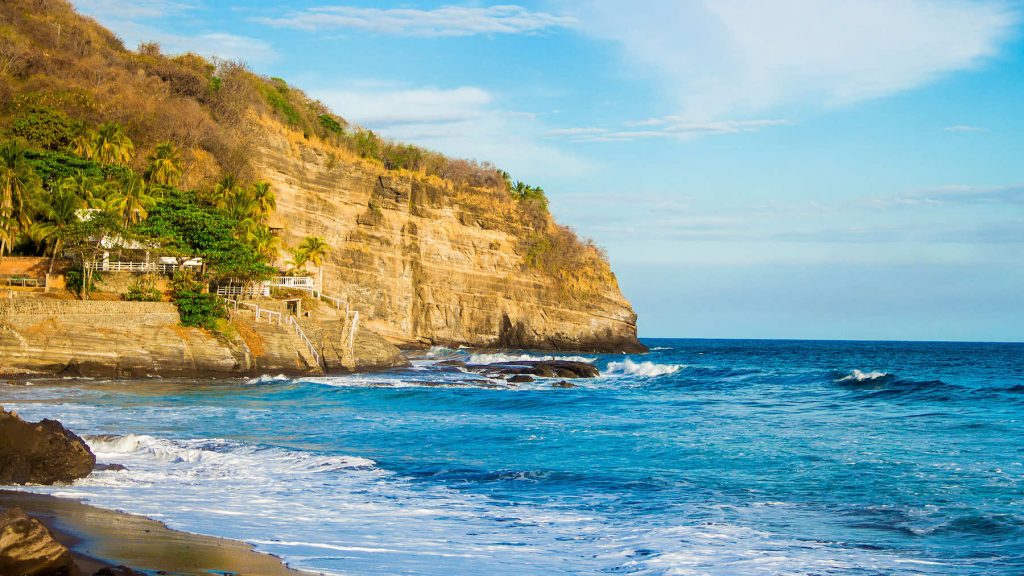
El Zonte © El Salvador Travel
The culture and art of El Salvador
Like its Central American neighbors, El Salvador was influenced by many different nations and cultures during the colonial period. Yet since declaring independence in 1821, El Salvador has become known for its own unique culture, which blends new ideas with mainstays of the previous era.
Ancient Mayan ruins
There are many Mayan ruins throughout Central America, but El Salvador, which was on the southeastern edge of the Mayan sphere of influence, has ruins that are unique compared to those found in the center of Mayan territory. The Joya de Cerén ruins are especially noteworthy, as they are called “Pompei of Americas”, they are an ancient village buried by a volcanic eruption and preserved intact These ruins lay dormant for over 1,300 years until their discovery in 1976, and UNESCO registered them as a World Heritage Site in 1993 for how they vividly illustrate ancient Mayan people’s way of life, and their remarkable state of preservation.
 Joya de Cerén (left) and El Tazumal (right) © El Salvador Travel
Joya de Cerén (left) and El Tazumal (right) © El Salvador Travel
Cultural events in many forms
The ancient capital of Suchitoto lies 47 km northeast of San Salvador. This city represents the colonial era of El Salvador and is also a center of modern Salvadoran culture, hosting the largest artificial lake and many of the country’s major events. These include annual international cultural events, like an international arts festival in February, a corn festival in August, and the Suchitoto International Film Festival in November.
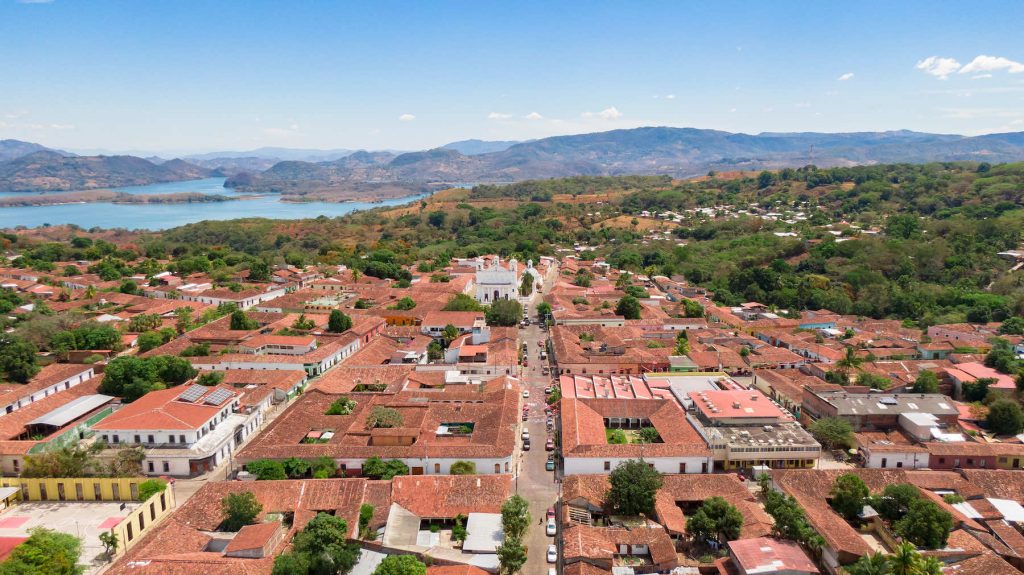 © El Salvador Travel
© El Salvador Travel
Suchitoto is also known for the traditional practice of indigo dying, and visitors can enjoy a tour through ancient installations as well as demonstrations of how indigo dying is now practiced as a modern industry with high-end clothes, bags, shoes and other products.
Close to Suchitoto, the Salvadoran “Balls of Fire” festival has been held in the city Nejapa since 1922. Just as the name suggests, this unique event features people throwing around balls of cloth that have been lit on fire. The most popular origin theory for this exciting event indicates that it honors those lost during a volcanic eruption in 1658.

© El Salvador Travel (left) ©Ministerio de Cultura de El Salvador (right)
La Palma’s handicrafts
La Palma in northern El Salvador is a village of artisans famous for the handicrafts created here. There are over a hundred workshops in this village that produce wood, ceramic and leather goods decorated with colorful, geometric patterns.
These patterns were introduced to the village by world-renowned Salvadoran artist Fernando Llort (1949–2018). He established the Semillas de Dios Gallery in La Palma, building a community that promoted production methods for these handicrafts as a part of local culture. As a result, La Palma’s handicrafts have developed into some of El Salvador’s most iconic products. Today, they’re beloved as souvenirs, of course, and hands-on workshops where visitors can create their own are also very popular.
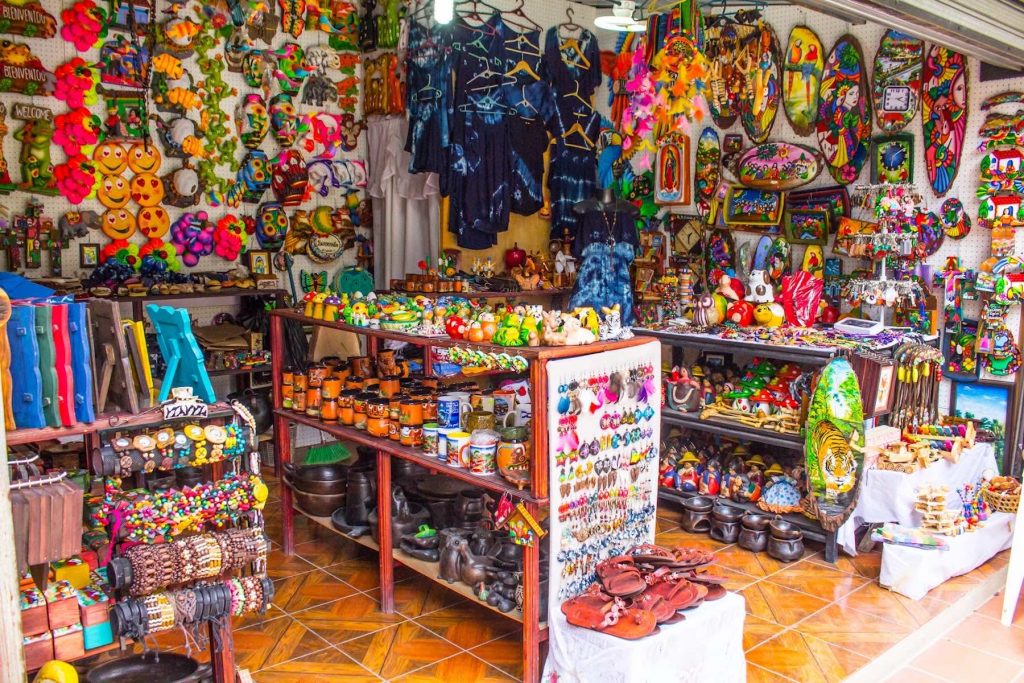 © El Salvador Travel
© El Salvador Travel
Musician recommended by the Embassy of the Republic of El Salvador in Japan
In closing, we would like to introduce musicians recommended by the Embassy of the Republic of El Salvador in Japan.
1. SI, MI CHIAMANO MIMI (OPERA LA BOHEME)-Gracia González
Gracia González is a Salvadoran soprano and she has participated in numerous concerts, recitals and operas at national and international level playing roles of great vocal difficulty.
- EL CARBONERO (THECOAL PICKER, FOLKLORIC SONG OF EL SALVADOR)-OPUS 503 (Lyrical Pop Trio)
OPUS 503 is the Lyrical Pop Trio formed by José Guerrero, Mauro Iglesias and Esaú Osorio. They have won several music awards and played in concerts in major cities around the world, such as New York, Los Angeles, Sevilla, Madrid, among others.
- EL ATOL DE ELOTE (CORN PUDDING, TROPICAL MUSIC)-Jhosse Lora
Jhosse Lora has received various awards at the national level and is a representative of Salvadoran salsa, merengue and cumbia music. He began his artistic career at an early age and currently has 51 years of musical work, he has recorded more than 30 albums and composed more than 175 songs.
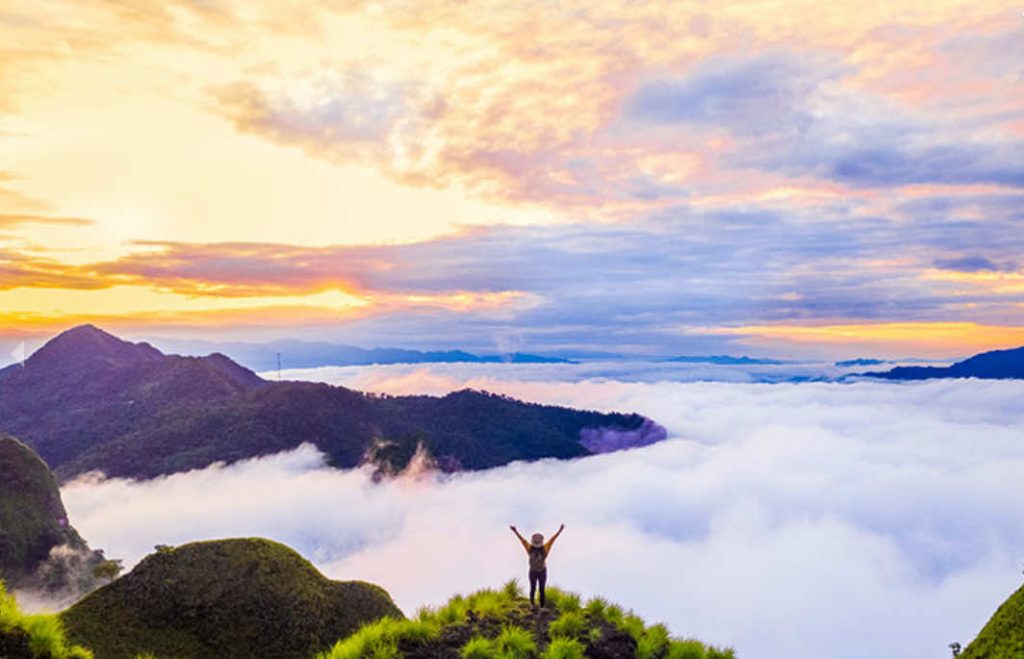 © El Salvador Travel
© El Salvador Travel
What did you think of your music journey to El Salvador? There are still many more places to go! Please look forward to our next destination.
(Produced in collaboration with the Embassy of the Republic of El Salvador in Japan. Photos provided by El Salvador Travel, Ministerio de Cultura de El Salvador and MITUR El Salvador.)
Min-On Concert Association
-Music Binds Our Hearts-


